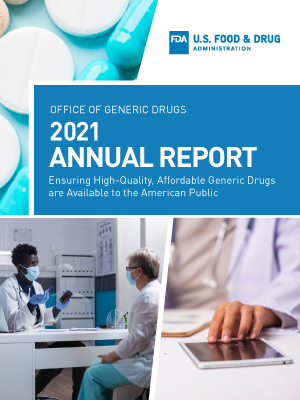Office of Generic Drugs 2021 Annual Report
Ensuring High-Quality, Affordable Generic Drugs are Available to the American Public
Table of Contents
- 2021 Generic Drug Program At-A-Glance
- Success Highlights
- GDUFA Science and Research in OGD
- Consistently and Efficiently Evaluating Generic Drugs and Monitoring Generic Drug Safety
- Advancing Bioequivalence and Generic Drug Assessments
- Policies that Support the Efficient Development of Safe, Effective, High-Quality, and more Affordable Generic Drugs
- Thank You to Our Collaborators
- Appendix
- Resources
Office of Generic Drugs 2021 Annual Report (PDF - 6 MB)
Director’s Message
Welcome to the seventh Annual Report from the Office of Generic Drugs (OGD) in the Center for Drug Evaluation and Research (CDER) of the U.S. Food and Drug Administration (FDA).
Ensuring that patients who need safe and effective medicines have greater access to them is a public health priority for the FDA. As you will read in this Report, the priority of access to more affordable medicines fits hand-in-hand with OGD’s mission to ensure high-quality, affordable generic drugs are made available to the American public. In this Report, I am pleased to share with you a snapshot of our successes.
Currently 90 percent—9 out of 10—of all prescriptions dispensed in the United States are for generic drugs. To make that possible, the generic drug program approves safe, effective, high-quality drugs and monitors those drugs once they are on the market.
How Did We Do in 2021?
This past year, the generic drug program approved hundreds of abbreviated new drug applications (ANDAs) and thousands of application supplements. Our office prioritized the assessment of generic drug submissions for potential treatments and supportive therapies for patients with COVID-19, approving more than 75 original ANDAs, some in record time,1 and since the beginning of the pandemic, more than 1,200 supplements. We funded approximately $20 million in generic drug science and research programs. We issued 149 product-specific guidances for generic drug development, including 54 for harder-to-develop complex drugs, to relay the agency’s thinking on the most appropriate methodology and evidence needed to support the development of specific generic drugs.
Innovation Helped Ensure the Public’s Access to More Affordable Medicines
In 2021, OGD scientific and programmatic innovations supported our generic drug assessment work. For instance, we established the scientific foundation to support alternative bioequivalence (BE) approaches for several generic drug products. One such example included a novel in vitro BE approach that directly resulted in the development, assessment, and approval of the first generic difluprednate ophthalmic emulsion (generic Durezol) used to treat eye swelling and pain after eye surgery.
Another innovation came with this year’s approval of the first generic paliperidone palmitate extended-release injectable suspension (generic Invega Sustenna), a long-acting injectable product indicated for the acute and maintenance treatment of schizophrenia in adults. The FDA developed modeling and simulation approaches for pharmacokinetic study designs and BE evaluations, which the applicant used. In yet another example, we approved the first complex generic for ferumoxytol injection (generic Feraheme), a parenteral (non-oral) iron product that treats iron deficiency anemia. Our scientific investment in the characterization of the product and advanced BE study designs was essential to this approval. Another successfully deployed programmatic innovation was an increase in the frequency of certain updates from month-ly to semi-monthly in the FDA’s electronic Orange Book. This change in update frequency is providing even more timely information about listed drug products, including their market status.
Scientific and Regulatory Collaboration Moved the Needle
Scientific and regulatory collaborations helped us create new approaches to support assessment of generic drug products in 2021.
FDA’s partnership with the University of Maryland and the University of Michigan (the Center for Research on Complex Generics) reached thousands of stakeholders worldwide with workshops that stimulated innovative dialogue and generated new knowledge about science and research crucial for the development of complex generic medicines.
Additionally, continued implementation of the congressionally established Competitive Generic Therapy (CGT) pathway helped us reach a milestone in 2021—approving 100 ANDAs designated as CGTs. The CGT pathway for generic drugs helps incentivize the entry of drugs with “inadequate generic competition” to the market. This milestone is a sign the CGT program is achieving its goal – the development and market availability of safe, effective generic drugs in areas of the market that previously had little to no competition.
Globally, 2021 marked the launch of a joint FDA and European Medicines Agency pilot program to provide parallel scientific advice to developers of complex generic drug products. The pilot allows assessors from the two agencies to concurrently communicate their views on scientific issues, in real time, to manufacturers working to develop complex generic drugs. This collaboration can help shorten the time it takes for these important products to obtain regulatory approval. The FDA also launched the Global Generic Drug Cluster, the first forum established for leading regulatory agencies to increase scientific alignment around topics relevant to the development of generic drugs.
In 2021, even with the unique challenges caused by the ongoing pandemic, OGD continued to innovate and conduct scientific research to keep the generic drug program moving forward. Today, the generic drug program is stronger than ever and continues to take timely actions to improve access to generic drug products. As always, this is good news for the American public.
Sally Choe, Ph.D.
Director, Office of Generic Drugs


